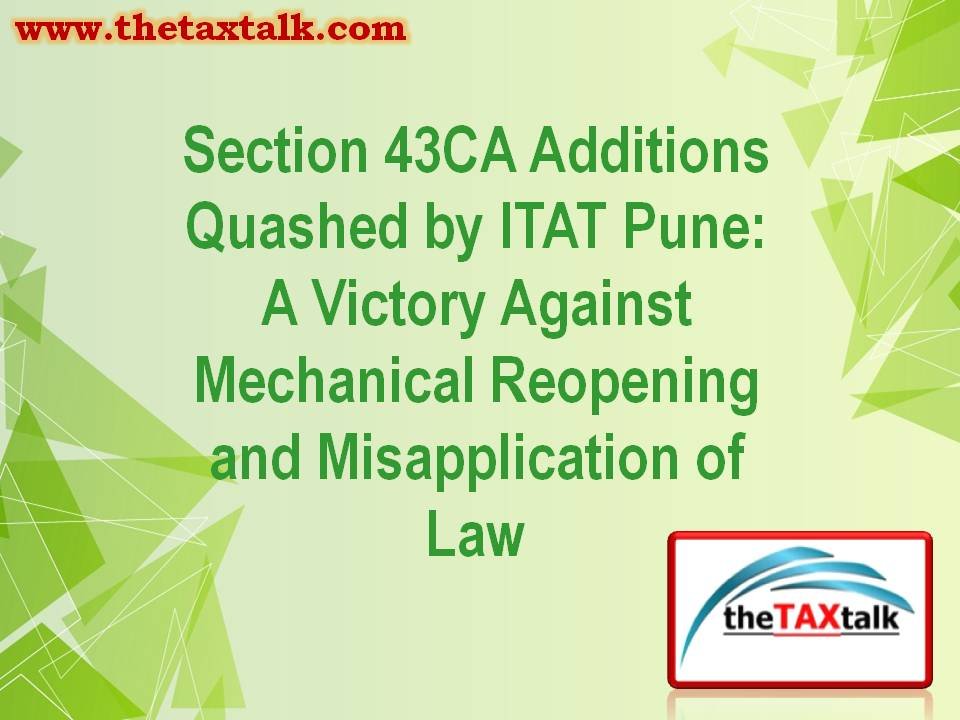![]()
Section 43CA Additions Quashed by ITAT Pune: A Victory Against Mechanical Reopening and Misapplication of Law
In a significant decision that reinforces the safeguards against arbitrary reopening of assessments and misuse of Section 43CA, the Income Tax Appellate Tribunal (ITAT), Pune Bench (SMC), has ruled in favour of the assessee, Om Shriniwas Developers, for Assessment Year 2016–17. The Tribunal not only quashed the reopening of the case under Section 148 but also held that the addition made under Section 43CA was invalid, given the less than 5% difference between the sale consideration and stamp duty value.
Let’s unpack the key issues, arguments, and the broader implications of ITAT Pune order in the case of Om Shriniwas Developers (ITA No. 1345/PUN/2025),
Background: A Case of Reassessment After Scrutiny
The assessee, a partnership firm engaged in real estate development, had filed its return of income for AY 2016–17 and was subjected to scrutiny under section 143(3). The scrutiny was limited and specifically directed at:
• Verification of income from real estate business,
• Genuineness of sundry creditors, and
• Allowability of interest expenses.
The Assessing Officer (AO), after detailed verification and submission by the assessee, had accepted the returned income and concluded the assessment without any additions.
Reopening Under Section 148: Same Facts, Different Opinion
Despite this, a notice under Section 148 was issued in June 2021, citing the alleged sale of two flats below their respective stamp duty values. The AO contended that the provisions of Section 43CA were applicable and that income to the extent of ₹2,18,495 had escaped assessment.
However, the information relied upon in the reopening proceedings was neither new nor previously undisclosed. It was part of the very assessment record examined under scrutiny. The reopening, thus, squarely fell into the trap of “change of opinion”—a judicially frowned-upon reason for reassessment, especially when the facts were already verified earlier.
The Tribunal highlighted this by referring to several binding decisions, including:
• First Source Solutions Ltd. v. ACIT (438 ITR 139)– where the Bombay High Court emphasized that reassessment without any failure of disclosure and based on the same material is without jurisdiction.
• Mira Bhavin Mehta v. ITO (W.P. No. 3246/2022)– where the Court held that reassessment was invalid if based on the same material already considered in scrutiny.
Section 43CA Addition Rejected: The 5% Tolerance Rule
The addition of ₹2,18,495 was made under Section 43CA, which deals with the consideration received from the transfer of real estate stock-in-trade. The AO’s grievance was that two flats had been sold for less than the stamp duty value.
However, the variation was minuscule:
|
Flat No. |
Sale Value | Stamp Duty Value | Difference |
% Difference |
|
101 |
₹23,00,000 | ₹23,90,595 | ₹90,595 | 3.93% |
| 202 | ₹27,10,100 | ₹28,38,000 | ₹1,27,900 |
4.72% |
Cumulatively, the difference was ₹2,18,495, but the Tribunal accepted the contention that this fell well within the permissible 5% tolerance margin introduced in Section 43CA via the Finance Act, 2020.
Though the amendment was effective from AY 2021–22, the ITAT followed judicial precedents that treat such provisions as retrospective in nature since they are curative and intended to remove hardship. Prominent among them is the ITAT Pune ruling in V.K. Developers vs. ACIT (ITA No. 923/PUN/2019), where it was held that the 5% margin in Section 43CA must be applied retrospectively to earlier years as well.
Judicial Discipline and Consistency in Interpretation
The Tribunal also cited multiple other cases where the tolerance margin under Section 43CA was upheld:
• Nisarg Developers v. DCIT(ITA No. 744/PUN/2024)
• City Corporation Ltd. v. DCIT(ITA No. 619/PUN/2020)
• Buttepatil Properties v. ITO(ITA No. 682/PUN/2018)
• Sai Bhargavanath Infra v. SCIT(ITA No. 1332/PUN/2019)
• Om Siddhakala Associates v. DCIT(Bombay HC W.P. No. 14178/2023)
These rulings solidify the principle that minor differences in valuation do not warrant additions under Section 43CA, especially when the discrepancy is within the prescribed threshold.
Final Verdict: A Lesson in Procedural Fairness
The ITAT Pune concluded the case with two clear determinations:
1. Reassessment Invalid: Since the reopening was based on information already scrutinized earlier, it amounted to a mere change of opinion. Hence, the notice under Section 148 was void ab initio.
2. Addition under Section 43CA Deleted: The variation in valuation being less than 5% rendered the addition unsustainable, and thus it was directed to be deleted.
While the Tribunal did not adjudicate the remaining grounds (including those on procedural defects under Section 148A and violation of jurisdiction under faceless assessment provisions), the decisive observations on change of opinion and tolerance limit under Section 43CA were enough to grant relief to the assessee.
Conclusion: A Case Worth Citing
This order is a textbook case for real estate developers and tax practitioners dealing with Section 43CA issues. It also reinforces the jurisprudence around reassessment proceedings, reminding authorities that mechanical reopenings based on old facts cannot override the principles of finality and fairness in assessment.
The case serves as both a warning against arbitrary reassessment and a ray of hope for assessees facing similar issues, particularly where small valuation differences are blown out of proportion during reassessment.
The copy of the order is as under:


